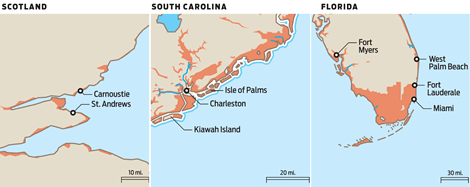Global Warming: Our Coast is Under Attack

The areas in orange above show land that would be affected by a sea-level rise of two meters. | National Science Foundation: View dynamic maps of areas susceptible to sea level rise
There are more than a thousand golf courses in the United States that can be considered "coastal." More than half of them could be gone by the end of this century because of global warming.
Research that Golf Digest commissioned from the Longitudes Group, which provides geographical research focused on recreational activities, suggests that of the 1,168 coastal courses less than two meters above sea level, 645 would in part or in total be submerged if sea levels were to rise in the next century. Courses like those at Kiawah Island Golf Resort in South Carolina, the TPC Sawgrass Stadium Course in Florida and Newport Country Club in Rhode Island all could be severely affected by a sea-level rise of two meters.
Though the conservative projection from the Intergovernmental Panel on Climate Change predicts about a half-meter rise in sea level before the turn of the century, this is a generalization. Others have suggested more alarming projections. A National Science Foundation-funded study two years ago predicted that if warming continues at its current pace, a six-meter rise in sea level by 2100 is possible. That kind of impact would eliminate the bottom third of Florida, and very likely would submerge much of the golf course property in coastal New Jersey, Maryland, Virginia and the Carolinas. (Of course, if that happens, there'll be much bigger issues than golf.)
"What happens is what we call inundation," says Robert Corell, global-change director at the H. John Heinz III Center for Science, Economics and the Environment in Washington, D.C. Inundation is the idea that low-lying areas will suffer much greater damage because of soft-soil erosion. "If you draw a line from Miami straight west, everything south of there is basically gone with one meter of sea-level rise," says Corell. "And a third to half of that is caused by this inundation where the storms come along and basically erode and erode. It's because the hard place that used to protect the land is gone."
It might be happening already. The Links Course at Wild Dunes in Isle of Palms, S.C., lost more than half of its 18th hole last fall. The one-time 501-yard par 5 is now a 190-yard par 3. Wild Dunes' 18th fell victim to high tides, higher winds and tropical storms. Some scientists believe the warming of the Earth means an increase in the intensity of the kinds of storms that can damage shorelines.
"I call climate change the cathedral problem," says Corell. "It took almost 200 years to build Notre Dame, and it's going to take that kind of time scale for all of us on Planet Earth to get our heads together and figure out how we're going to slow down the warming of our planet."
Want to know if your course is in jeopardy? Click here to view a complete list of courses in jeopardy of flooding.

